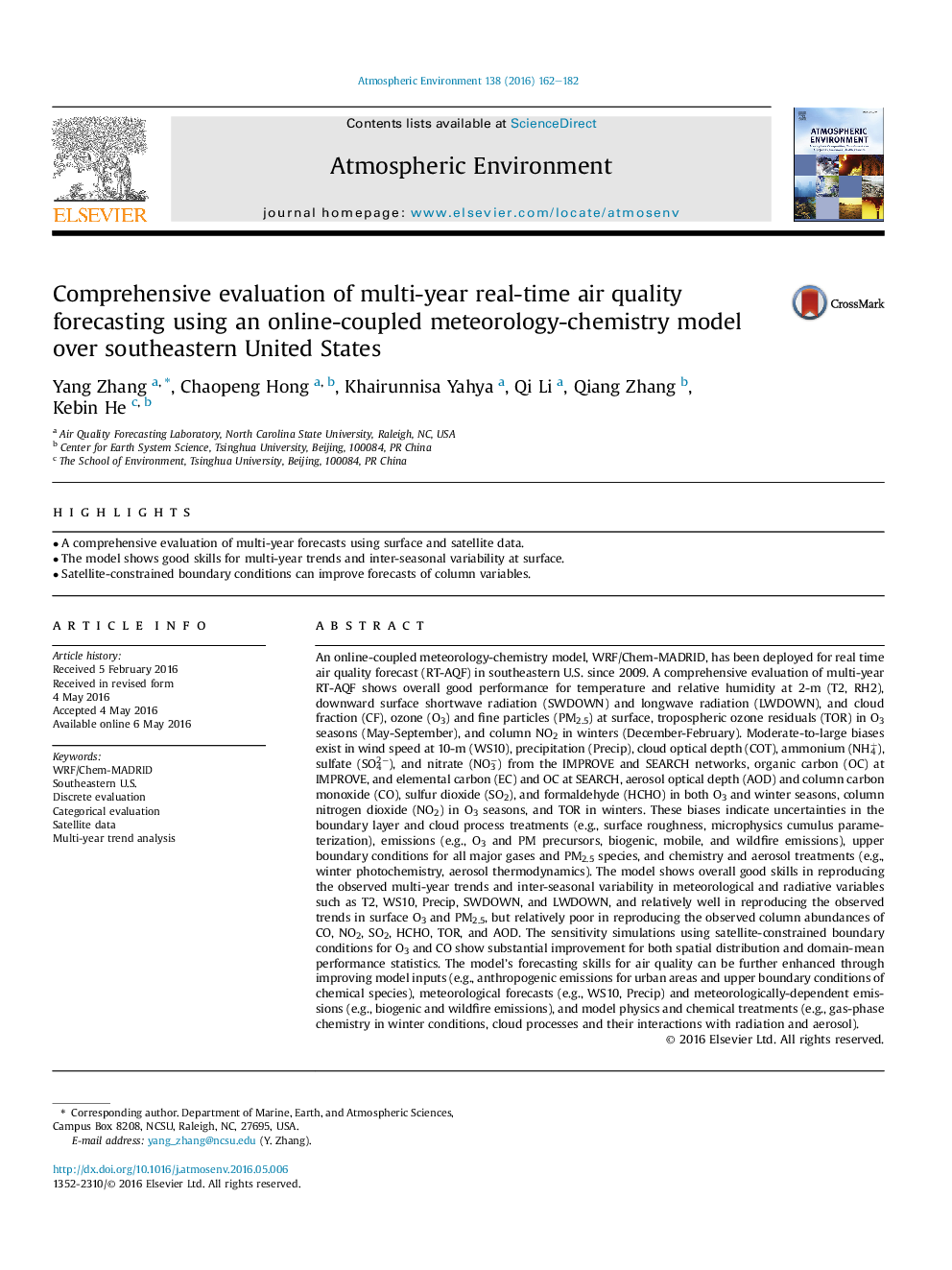| کد مقاله | کد نشریه | سال انتشار | مقاله انگلیسی | نسخه تمام متن |
|---|---|---|---|---|
| 6336550 | 1620336 | 2016 | 21 صفحه PDF | دانلود رایگان |
عنوان انگلیسی مقاله ISI
Comprehensive evaluation of multi-year real-time air quality forecasting using an online-coupled meteorology-chemistry model over southeastern United States
ترجمه فارسی عنوان
ارزیابی جامع از پیش بینی کیفیت هوا در چند سال گذشته با استفاده از مدل هواشناسی-شیمیایی آنلاین در جنوب شرقی ایالات متحده
دانلود مقاله + سفارش ترجمه
دانلود مقاله ISI انگلیسی
رایگان برای ایرانیان
موضوعات مرتبط
مهندسی و علوم پایه
علوم زمین و سیارات
علم هواشناسی
چکیده انگلیسی
An online-coupled meteorology-chemistry model, WRF/Chem-MADRID, has been deployed for real time air quality forecast (RT-AQF) in southeastern U.S. since 2009. A comprehensive evaluation of multi-year RT-AQF shows overall good performance for temperature and relative humidity at 2-m (T2, RH2), downward surface shortwave radiation (SWDOWN) and longwave radiation (LWDOWN), and cloud fraction (CF), ozone (O3) and fine particles (PM2.5) at surface, tropospheric ozone residuals (TOR) in O3 seasons (May-September), and column NO2 in winters (December-February). Moderate-to-large biases exist in wind speed at 10-m (WS10), precipitation (Precip), cloud optical depth (COT), ammonium (NH4+), sulfate (SO42â), and nitrate (NO3â) from the IMPROVE and SEARCH networks, organic carbon (OC) at IMPROVE, and elemental carbon (EC) and OC at SEARCH, aerosol optical depth (AOD) and column carbon monoxide (CO), sulfur dioxide (SO2), and formaldehyde (HCHO) in both O3 and winter seasons, column nitrogen dioxide (NO2) in O3 seasons, and TOR in winters. These biases indicate uncertainties in the boundary layer and cloud process treatments (e.g., surface roughness, microphysics cumulus parameterization), emissions (e.g., O3 and PM precursors, biogenic, mobile, and wildfire emissions), upper boundary conditions for all major gases and PM2.5 species, and chemistry and aerosol treatments (e.g., winter photochemistry, aerosol thermodynamics). The model shows overall good skills in reproducing the observed multi-year trends and inter-seasonal variability in meteorological and radiative variables such as T2, WS10, Precip, SWDOWN, and LWDOWN, and relatively well in reproducing the observed trends in surface O3 and PM2.5, but relatively poor in reproducing the observed column abundances of CO, NO2, SO2, HCHO, TOR, and AOD. The sensitivity simulations using satellite-constrained boundary conditions for O3 and CO show substantial improvement for both spatial distribution and domain-mean performance statistics. The model's forecasting skills for air quality can be further enhanced through improving model inputs (e.g., anthropogenic emissions for urban areas and upper boundary conditions of chemical species), meteorological forecasts (e.g., WS10, Precip) and meteorologically-dependent emissions (e.g., biogenic and wildfire emissions), and model physics and chemical treatments (e.g., gas-phase chemistry in winter conditions, cloud processes and their interactions with radiation and aerosol).
ناشر
Database: Elsevier - ScienceDirect (ساینس دایرکت)
Journal: Atmospheric Environment - Volume 138, August 2016, Pages 162-182
Journal: Atmospheric Environment - Volume 138, August 2016, Pages 162-182
نویسندگان
Yang Zhang, Chaopeng Hong, Khairunnisa Yahya, Qi Li, Qiang Zhang, Kebin He,
